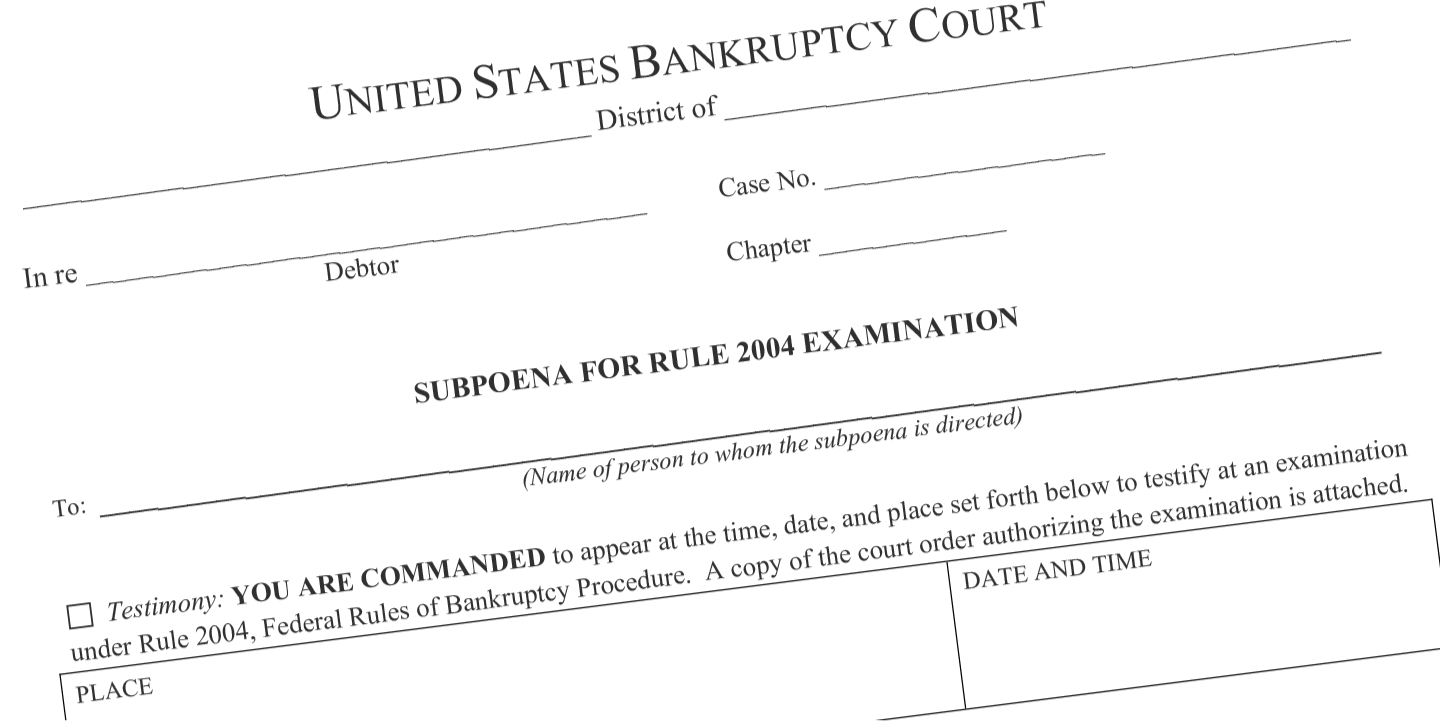For the average bankruptcy filer, a bankruptcy case ends (or basically ends) at the conclusion of the 341 Meeting of Creditors, or at the confirmation of a Chapter 13 Plan. Every once in awhile, however, a debtor will find himself/herself facing an additonal “examination” within the bankruptcy. This is called the 2004 Examination. It has nothing to do with the year 2004, despite what this lawyer thought when she first started practicing, but instead refers to rule 2004 of the Federal Rules of Bankruptcy Procedure . Rule 2004 states that any party in interest to the bankruptcy may request that the Court allow the examination of any entity, including the debtor. The party in interest can also request that any entity produce relevant documents for examination. The 2004 exam is often a confusing and scary procedure for a debtor, but is a useful tool for the case trustee and any other party looking to broadly investigate the debtor’s affairs.
Typically, I have seen the 2004 Exam used by a case trustee who believes there may be something more to a bankruptcy case and who wants to continue the investigation beyond the constraints of the 341 Meeting of Creditors. The trustees are very limited on time at the 341 Meetings and cannot delve too deeply into the debtor’s financial affairs. If the trustee believes there may be more assets than stated or transfers that may not be legitimate, he/she will request a 2004 Exam to ask further questions about these issues. Another scenario that commonly triggers the request for a 2004 Exam is when a debtor owns or has owned a business. Trustees may request a 2004 Exam to investigate the business books and financial records.
So, what does the exam mean for the debtor? For a debtor that has fully disclosed all of his/her assets and information on his/her bankruptcy petition, the 2004 Exam is mostly a formality. The trustee will usually hire an attorney to handle the exam and requests for documents. The requested documents are generally due within a week or two before the scheduled examination date and must be delivered to the attorney conducting the examination. The examination can last a couple of hours, but if you have prepared sufficient documents, it may be much shorter. Usually, the request for documents will narrow the scope of the examination, but really any topic is open for questioning. The Exam is run similar to a deposition and is usually held at an attorney’s office or some other mutually determined location. If there is a question that you feel you need to discuss with your attorney, it is perfectly acceptable to ask for a private moment with your own counsel. Depending on the nature of the opposing counsel, he/she may provide you and your attorney with their thoughts on how the case will proceed and if the issues have been resolved by the examination. Overall, if you have been honest, the 2004 Exam will be a hassle, but nothing to lose sleep over.
Because the reach of the 2004 Exam is so broad, encompassing any “entity,” one might wonder if a debtor subject to this Exam has any protections. The answer is yes. The most significant protection is that the requests of the 2004 Exam cannot subject an examinee to “undue burden.” Federal Rule of Civil Procedure 45(c)(3)(A)(iv). Undue burden usually focuses on the cost of the request. Would the cost to the examinee to procure, copy and produce the documents outweigh the value of those documents? However, a debtor or other entity may be able to argue that there are other burdens or hardships involved in complying with the 2004 Exam.
Regardless of the situation, the 2004 Exam shows us that bankruptcy is a serious court proceeding. The best step for avoiding any bankruptcy “tests” is to provide full disclosure to your bankruptcy attorney from the start.
Set up a consultation with one of our experienced bankruptcy attorneys. Contact Perez Law Group, PLLC at (602) 730-7100.
